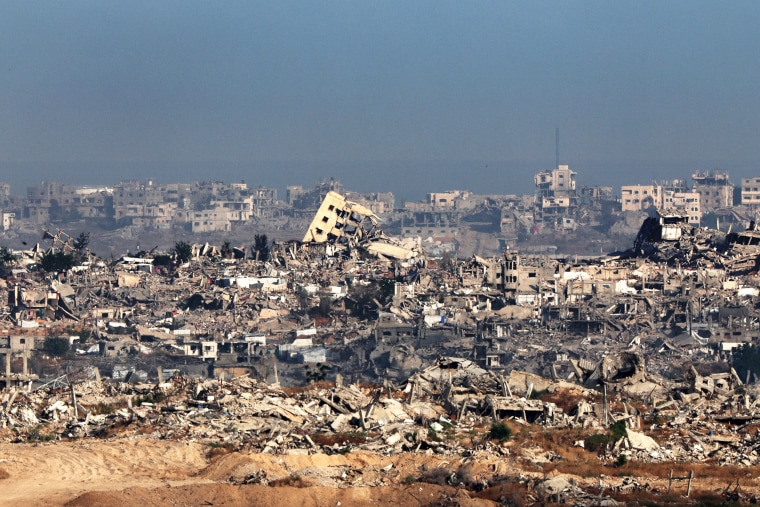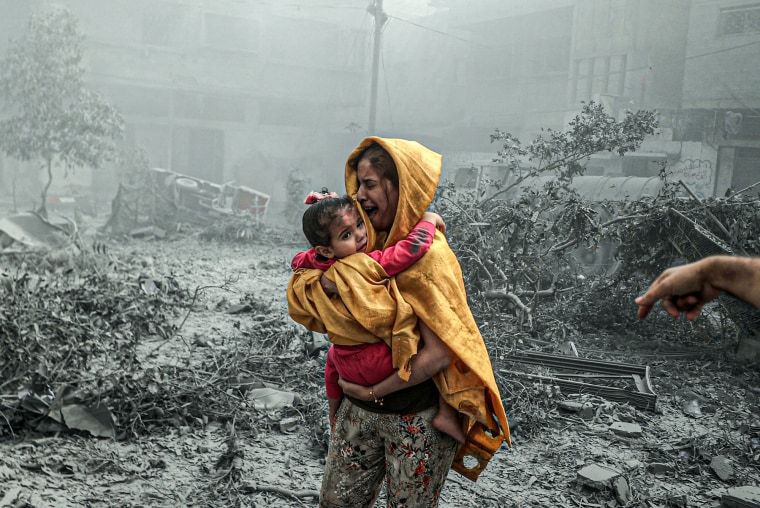In a column last week arguing that Israel isn’t committing genocide in the Gaza Strip, The New York Times’ Bret Stephens said the excessive civilian deaths in the enclave are due to Israel’s “bungled humanitarian schemes,” isolated cases of “trigger-happy soldiers” and mistaken targets in a manner consistent with war “in its usual tragic dimensions.” Israel doesn’t have genocidal intentions, Stephens argued, because there appears not to be an “Israeli plan” to commit genocide and because Israel hasn’t sought to kill everyone in the Gaza Strip.
Defenders of Israel’s barbaric cruelty seem to require the discovery of a binder labeled “genocide plan” and the recorded deaths of most of Gaza’s population in order to change their minds. But neither a written plan nor the deaths of most Gazans is needed to characterize Israel’s conduct as genocidal. A significant and growing number of human rights organizations, legal scholars and historians of genocide have been saying as much and sounding the alarm about what Israel is doing for more than a year.
Calling the atrocity in Gaza something other than genocide requires us to deny what history has taught us.
Stephens’ opinion wouldn’t matter so much if it didn’t typify an argument one hears from so many people in the United States that Israel is simply waging a war that, from time to time, has gotten a bit out of hand. That view isn’t confined to the right. Only a few left-wing Democrats, such as Rep. Ilhan Omar of Minnesota, have accused Israel of genocide, while the rest of the party and its leaders have occasionally gently chided Israel for brutalizing Palestinians too much or encouraged Israel to let through a little more humanitarian aid without ever questioning the premise of Israel’s operation.
Even now, as Israel starves civilians and shoots many of those who try to obtain what little food is available, Democrats are either calling what Israel is doing a strategic mistake or using the passive voice to describe an “unfolding” famine. And always there’s the reiteration of Israel’s right to defend itself against Hamas, even though that has nothing to do with Israel’s humanitarian obligations under international law. Former President Barack Obama, a gifted writer, released an evasive statement that starts with a throat-clearing caveat calling for “a return of all hostages” and refuses to name Israel as the agent behind the starvation of Gaza. No Democratic leader in Congress has called for the United States to cut ties with Israel, nor do they acknowledge that Israel unilaterally withdrew from the ceasefire with Hamas.
Israel is showing the world how to pull off a genocide in broad daylight in 2025 with the patronage and diplomatic support of the West. The country is able to pursue the ethnic cleansing of the Gaza Strip and cull the population through the incremental killing of civilians by perpetually invoking security goals and paying lip service to the idea of humanitarianism and “minimizing” casualties. This slow-motion extermination allows Israel and the West to maintain a veneer of plausible deniability while also pursuing long-standing geopolitical interests. But calling the atrocity in Gaza something other than genocide requires us to deny what history has taught us — and to deny what we can see with our eyes.
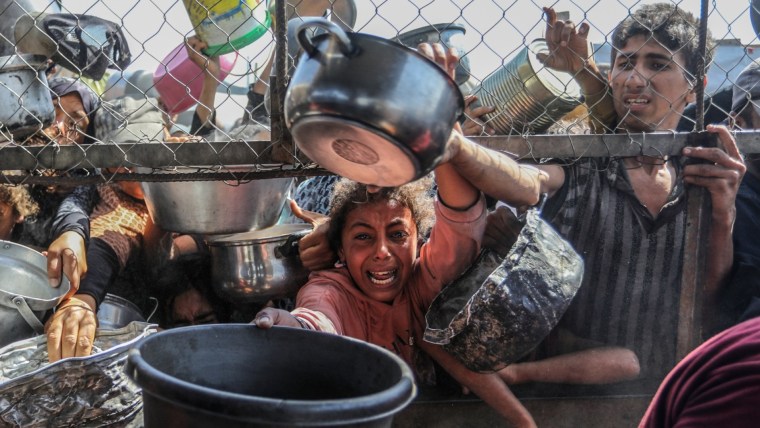
Historians of genocide say that most genocides aren’t announced as such. Genocidal regimes — including the Nazis — have used coded and euphemistic language to describe their objectives and their operations, especially in the early stages. “Genocidal organizations or states say they have security issues. They say their existence is threatened. They say there’s an enemy from within. They say all kinds of things,” Omer Bartov, an Israeli American professor of Holocaust and Genocide Studies at Brown University, told me. Israel has invoked those kinds of justifications. But, Bartov added, Israel has been unusual in its forthrightness: “The weird thing in this case is actually that genocidal pronouncements were made right at the beginning.”
The crime of genocide is defined by the United Nations as the “intent to destroy, in whole or in part, a national, ethnical, racial or religious group, as such.” In the weeks after Hamas’ vicious Oct. 7, 2023, war crimes, Israeli Defense Minister Yoav Gallant said Israel was “fighting human animals” in Gaza while announcing a siege cutting off food, water, fuel, electricity and medicine to the entire Gaza Strip. Israeli Prime Minister Benjamin Netanyahu said that “we will operate forcefully everywhere” in Gaza and called on Israelis to remember “what Amalek did to you,” which, Bartov points out, “many interpreted as a reference to the demand in a biblical passage calling for the Israelites to ‘kill alike men and women, infants and sucklings,’ of their ancient enemy.”
Israeli government officials also declared that there were “no uninvolved civilians” in the territory and called for the “total annihilation” of cities and for “erasing the Gaza Strip from the face of the earth.” There are scores of other examples of incitement to genocide, and the statements are continuing to this day. (Israel denies it is committing genocide and says its operation in Gaza is one of self-defense after Hamas killed 1,200 people, most of whom were civilians, and took over 250 hostages.)
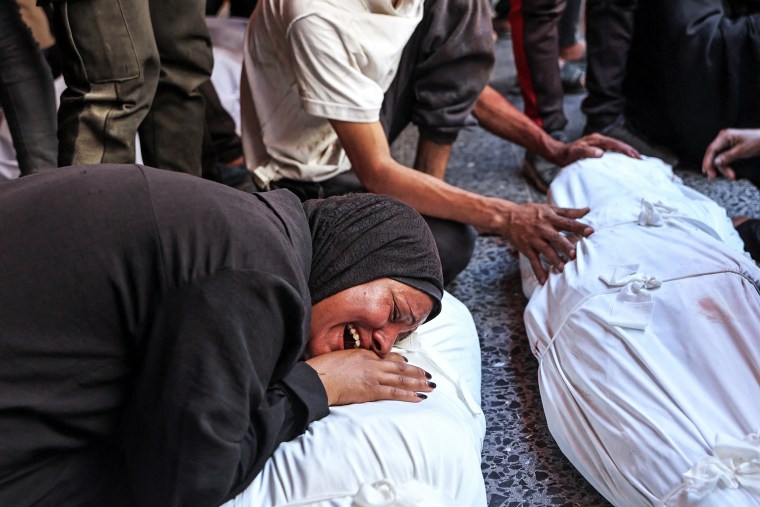
Public statements from politicians and military officials “provide a very, very important part of identifying the intent, because it gives you some idea of what the leaders of the country intend to do,” William Schabas, a professor of international law at Middlesex University and a former president of the International Association of Genocide Scholars, told me. Schabas says those statements can’t be waved away as overheated rhetoric because they match Israel’s actual actions on the ground.
The Israel Defense Forces boasted about warning Gazans in advance about airstrikes in certain areas and designating safe zones — the kind of talking points that Stephens and like-minded people uncritically recite when making their case that Israel isn’t engaged in genocide. But they ignore that Israel went ahead with bombing its “safe zones” and carried out an air campaign that leveled entire blocks and wiped out entire families. The United Nations said Israel’s air campaign has “consistently violated” international laws requiring minimizing civilian harm. Consider that in just the first week of its campaign against Hamas in Gaza, Israel bombed the tiny strip of land with 20,000 people per square mile with nearly as many bombs as the U.S.-led coalition dropped over all of Afghanistan in its heaviest year of bombardment.
Israel’s systematic destruction of residential, educational, medical and cultural infrastructure demonstrates an agenda to prevent Gaza from being able to reconstitute itself as a group and a society. And Israel has consistently used the reduction and cutting off of food, water, medical supplies and energy to the entire territory as a weapon of war — a violation of international law and a clear-as-day demonstration of attacking the people of Gaza as a group.

Israel’s use of deprivation as a tool against all Gazans reached a terrifying new stage in May, when it replaced the long-established United Nations infrastructure for distributing aid across the strip with the Orwellian-sounding “Gaza Humanitarian Foundation.” Hundreds of aid distribution sites capable of handing out supplies door-to-door have largely been replaced with a mere four sites run by a private U.S.- and Israeli-backed organization and supported by U.S. security contractors. Three of the sites are in the south and difficult for much of the population of over two million Gazans to access, and all of them are in military zones. "The GHF system is like standing at the edge of a big pond and feeding the fish by throwing breadcrumbs. Who gets to eat its rations?"Alex de Waal, an expert on famine and the executive director of the World Peace Foundation at Tufts University in Massachusetts, wrote in The Guardian.
Close to a thousand people have been shot and killed while seeking food, according to the United Nations. A former retired Green Beret who worked at the GHF sites said that they “were designed as death traps” and that he witnessed civilians being targeted. (“Death trap” is also the term used by a U.N. official to describe the new system.) Humanitarian and famine experts say that the program can’t possibly feed everyone in the territory and that it also “humiliates and undermines” the population. In other words, the GHF is perfectly designed to allow Israel to say it’s doing something for Gaza while winnowing down the population.
Destroying Gaza’s population helps the Israeli government advance the project of ethnic cleansing.
How many corpses does it take for an assault on a group to reach the threshold of genocide? It’s a grisly question, and Stephens — and apparently the majority of Democrats in Washington — don’t believe the body count is high enough for that designation. But under the legally binding U.N. definition of genocide, a culprit doesn’t necessarily have to have killed a certain number of people. A state or a group can also be charged with genocide for “causing serious bodily or mental harm to members of the group” or “deliberately inflicting on the group conditions of life calculated to bring about its physical destruction in whole or in part.” Undoubtedly, Gaza qualifies.
However, even under the provision of the U.N. law which specifically designates killings as genocidal, Gaza meets the threshold, Schabas says. Schabas points out that the Srebrenica massacre in 1995, in which Bosnian Serb forces killed around 8,000 Bosnian Muslim men and boys, was ruled a genocide by the International Court of Justice and the International Criminal Tribunal for the former Yugoslavia. The Bosnian Muslim population was around 1.4 million at the time, and notably, the Bosnian Serb forces deliberately spared women, some children and the elderly — but that didn’t change the judgment that Bosnian Muslims had been targeted and killed as a group. Gaza health authorities say the casualty rate in Gaza has exceeded 60,000, more than half of which are women and children, and public health experts believe that to be a significant undercount due to a breakdown in the health care system, people trapped under the rubble and the challenge of documenting “indirect deaths” tied to disease and malnutrition.
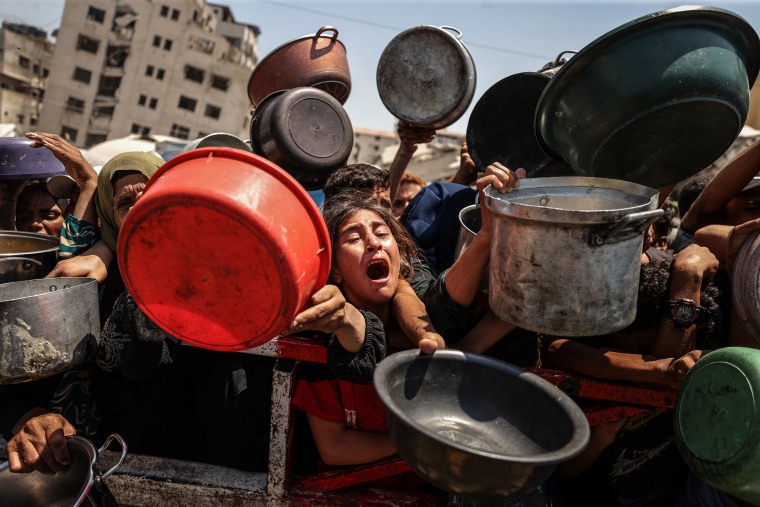
Destroying a group "in part" serves a function. Reducing and degrading Gaza’s population helps the Israeli government advance the project of ethnic cleansing. Israel’s far-right government officials have spoken openly about annexing territory in Gaza and petitioned for Palestinians to leave the territory for another country (on Israel’s terms; Gazans are barred from exiting the enclave unless given permission) and are reportedly in talks with other countries to absorb Gaza’s remaining population. Noura Erakat, a human rights attorney and professor at Rutgers University, said in an email that Netanyahu’s government “has sought to make Gaza unlivable so that any surviving Palestinians are forced to leave Gaza to live,” as part of the broader project of achieving “Nakba peace,” or the establishment of security achieved through the removal of Palestinians.
The incremental killing of Gaza also helps Israel and its patron states in the West sell the idea that what it’s doing is simply a war and maintain the lie that the West remains committed to human rights. Too many deaths too quickly would make Israel overly vulnerable to becoming a pariah state.
Whether Israel is committing genocide has nothing to do with what people — be they Bret Stephens or Barack Obama — feel in their gut. It has nothing to do with whether what’s happening in Gaza looks just like what the Nazis did during the Holocaust or whether it looks like what the Hutus did to the Tutsis in Rwanda. What matters is whether Israel has displayed the intent and taken actions that seek to destroy Gazans for being Gazans. The evidence says yes.
